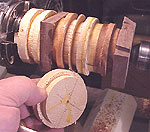This is a Veteran Owned site
"Scrap" MalletText and photos by Tom Hintz One of the by products of many chuck-based turning processes is a cut-off tenon, sometimes called a spigot. When I first started using my lathe I threw these remnants in the trash, but lately began keeping the better ones as it occurred to me I could glue them up to make something useful.
When the glue dries, the second spigot is faced off and the process repeated, applying additional spigots until the desired length is achieved. I often add one or two additional spigots to secure the glue-up in the chuck and provide sufficient material to allow parting the finished piece away. A favorite project for these glue-ups is a shop mallet. I currently have three of these mallets in the shop, turned to various sizes. All of them come in very handy for jobs that need a little gentle persuasion with minimal marking of the material. The mallet in the accompanying photos is most often used for setting inlays and tapping dovetail joints together. The 11"-long by 1 ¼"-diameter (maximum point) handle was turned from a glue up made by laminating two pieces of walnut with a ¼"-thick strip of red oak between them. A 1"-diameter tenon was turned at the head end of the handle to fit into a 1"-diameter socket drilled into the head. The head and handle were treated with one coat of Hut's Crystal Coat friction finish, followed by two thin coats of Staples Crystal Clear Paste Wax, both while still on the lathe. |
||
Do you have a comment about this page? - Email Me! |
All written, photographic and drawn materials are property of and copyright by NewWoodworker.com LLC 2000-2019. Materials may not be used in any way without the written permission of the owner.


